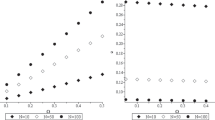Abstract
A firm may have an incentive to encourage competition and/or efficiency in an “aftermarket” that is vertically linked to a “foremarket” in which it participates. I describe a strong form of this potential incentive, and then explore how it is weakened in plausible circumstances. Some applications to net neutrality are described.
Similar content being viewed by others
Notes
I believe that one could legitimately use more than one concept of price here, provided that one is consistent; but the perceived system price most directly drives demand.
Severin Borenstein has suggested a possible illustration: In airlines, the introduction of “premium economy” seating, or more generally the shifting around in relative amenities and terms that are offered by airlines to different groups of passengers, repeatedly changes the identity of “the marginal customer” (for any one airline, or, if it matters, for the industry).
References
Agarwal, S., Chomsisengphet, S., Mahoney, N., & Stroebel, J. (2015). Regulating consumer financial products: Evidence from credit cards. The Quarterly Journal of Economics, 130(1), 111–164.
Borenstein, S., MacKie-Mason, J., & Netz, J. (2000). Exercising market power in proprietary aftermarkets. Journal of Economics and Management Strategy, 9, 157–188.
Cabral, L. (2014). Aftermarket power and foremarket competition. International Journal of Industrial Organization, 35, 60–69.
Carlton, D., & Waldman, M. (2010). Competition, monopoly, and aftermarkets. Journal of Law Economics and Organization, 26, 54–91.
Coppi, L. (2007). Aftermarket monopolization: The emerging consensus in economics. Antitrust Bulletin, 52, 53–71.
Farrell, J. (2012). Can privacy be just another good? The Journal on Telecommunications and High-Technology Law, 10, 251–264.
Farrell, J., & Weiser, P. (2003). Modularity, vertical integration, and open access policies. Harvard Journal of Law and Technology, 17, 85–134.
O’Brien, D., & Smith, D. (2014). Privacy in online markets: A welfare analysis of demand rotations. Federal Trade Commission Bureau of Economics working paper no. 323.
Shapiro, C. (1995). Aftermarkets and consumer welfare: Making sense of Kodak. Antitrust Law Journal, 63, 483–511.
Spence, M. (1975). Monopoly, quality and regulation. Bell Journal of Economics, 6, 417–429.
U.S. Department of Justice and Federal Trade Commission. (2010). Horizontal merger guidelines.
Veiga, A., & Weyl, G. (2016). Product design in selection markets. Quarterly Journal of Economics, 131, 1007–1056.
Author information
Authors and Affiliations
Corresponding author
Rights and permissions
About this article
Cite this article
Farrell, J. Some Simple Analytics of Vertically Linked Markets. Rev Ind Organ 50, 431–440 (2017). https://doi.org/10.1007/s11151-017-9571-2
Published:
Issue Date:
DOI: https://doi.org/10.1007/s11151-017-9571-2




